People considering taking control of their electricity and being self-sufficient with solar panels often ask us if cloudy days affect solar panels. Hint: They’re called solar panels for a reason.
While solar panels are affected by cloudy days, that doesn’t necessarily mean that you won’t get any electricity out of the panels. The simplest way to make this point is how a cloudy day still has sunlight.
How much power do you lose on cloudy days?
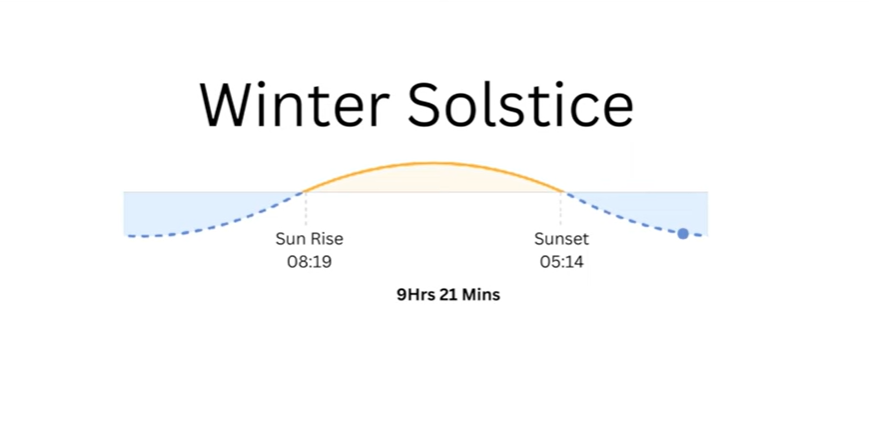
You lose 50% of prime time producing hours if you het 5 hours of cloud cover.
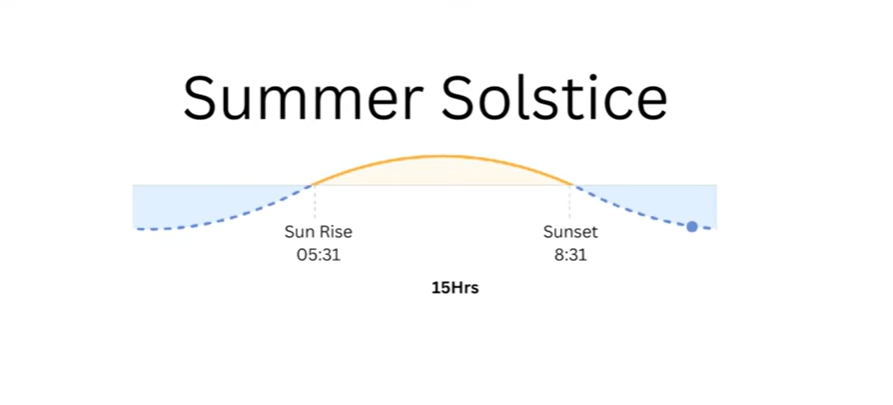
You lose only 35% of the time you can produce electricity if you get 5 hours of cloud cover.
Depending on the cloud cover level, you may lose output by as much as 80%, or even more, if you have cloud cover the entire day. This is further impacted by the time of year.
If you get 5 hours of cloud cover during the shortest days of the year when you have 10 hours of sunlight, you lose 50% of your prime time-producing hours.
If you get 5 hours of cloud cover on the longer days of the year when daylight is out for 14 hours, you lose only 35% of the time you can produce electricity.
Another thing to consider is where the panels are installed on your roof or what direction they are pointing in. Solar panels installed in coastal areas where the mornings are more likely to have cloud cover will lose morning output compared to other regions that wake up to a blue sky with the sunrise. This latter point of panel orientation relative to cloud cover is especially important in areas with time-of-use rates or demand charges.
For example, you have solar panels installed on the east side of the roof. On a sunny morning, you start producing power right as the sun rises and hits your solar panels; great! Now let’s imagine that you wake up tomorrow to early morning cloud cover that burns off by about noon. By noon, the sun has moved from the east to about the south side of your home. As the sun continues to move through the sky, it will shift to the west side of the house and eventually set.
In this example, the prime hours on the east-facing roof are between sunrise and noon.

If you can place panels on the south or west side of your roof, you are more likely to have a system on your roof that will produce more on a cloudy day if those clouds burn off during the day. But even if the solar panels aren’t producing as much power because of shade, they still produce power. Most solar panel systems come with a monitoring system you can look at through your computer or mobile device. Let’s take a look at what you anticipate seeing in your monitoring application on a sunny vs. cloudy day.
The solar panel monitoring will reflect output in different time windows from the day, week, month, year, or lifetime. You will want to confirm you are looking through the day lens. Also, you will want to look at this in the latter part of the day or a previous day, so you get the whole picture. What you want to see is a nice bell curve. One that starts early in the AM as soon as the panels start producing power. Then as time passes in the day, the system will top out at peak production. This peak will come at different times depending on the orientation of your panels.
If your panels are facing east, the peak will happen earlier in the day. If they’re facing south, it should happen right around the middle of the day. But if they’re facing west, the peak will move to the latter part of the day. This results from panels being hit at a direct angle at different times of the day as the sun moves through the sky and depending on where your panels are installed.
Now let’s compare this sunny bell curve to a cloudy day. We would rather have a spiky bell curve instead of a nice smooth bell curve, as we described earlier. This is a result of two things. The sun moves through the sky, and the cloud cover moves over the solar panels.
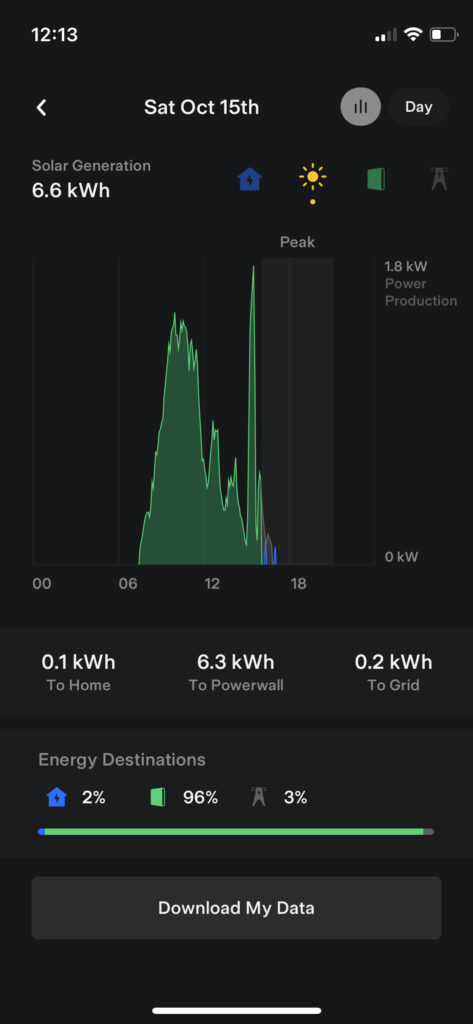
Solar generation on a cloudy day.
As the cloud cover decreases, you will see a spike in output. But as soon as the cloud cover moves over the panels again, you can see the drop. On this cloudy day, the solar generation for the entire day was just over 6.6kWh. While on this lovely sunny day, the system got almost 28kWh of solar generation.
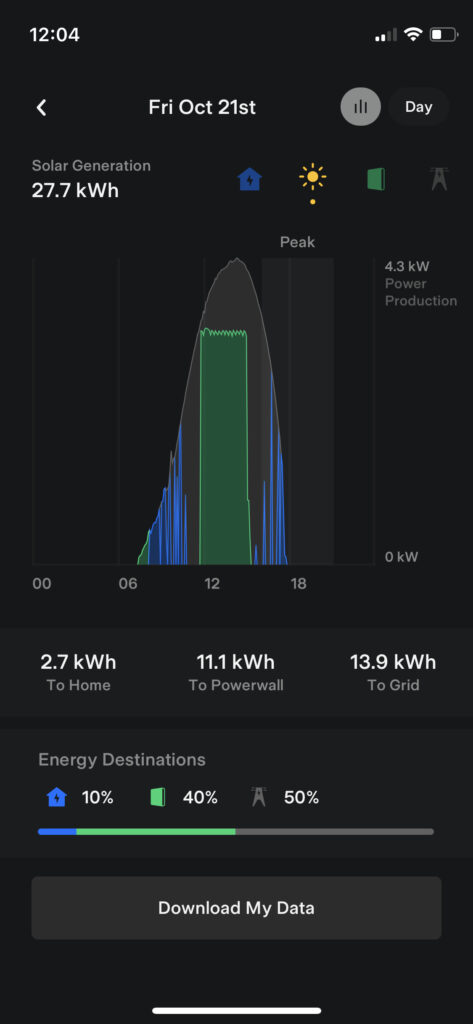
Solar generation on a sunny day.
To give you another example, if you monitor in real-time, the system at around 11am is producing 1.5kW of output due to cloud cover. But when the clouds have passed or burned off, the solar energy output increases to 10kW an hour later. As a side note, the system in this example also has a battery installed. This is worth mentioning because if you only have an east-facing roof and you also live in an area with time of use or peak demand charges. In that case, a battery may save whatever power you produce in the AM with your east-facing roof and make it available later in the day when the electricity rates have increased. This factors into how net metering and time-of-use rates work.
DroneQuote understands cloud cover issues
What our clients love about DroneQuote is how we educate them about the solar or roof buying process rather than an effort to close the sale at all costs. Our interest revolves around being a fiduciary to you rather than a sales organization. Sometimes, we suggest to prospects that they not buy solar based on their expectations. You can always count on us to tell you why we make the recommendations. We would tell you how they would benefit you. Including being knowledgeable about details like how cloud cover affects your solar panels and where we recommend installing your solar for the most effective result. If you would like more information on how we can serve you, or if you’d like to start by ordering a drone survey for your home to get the most accurate quotes for solar or roofing, please check us out at dronequote.net.
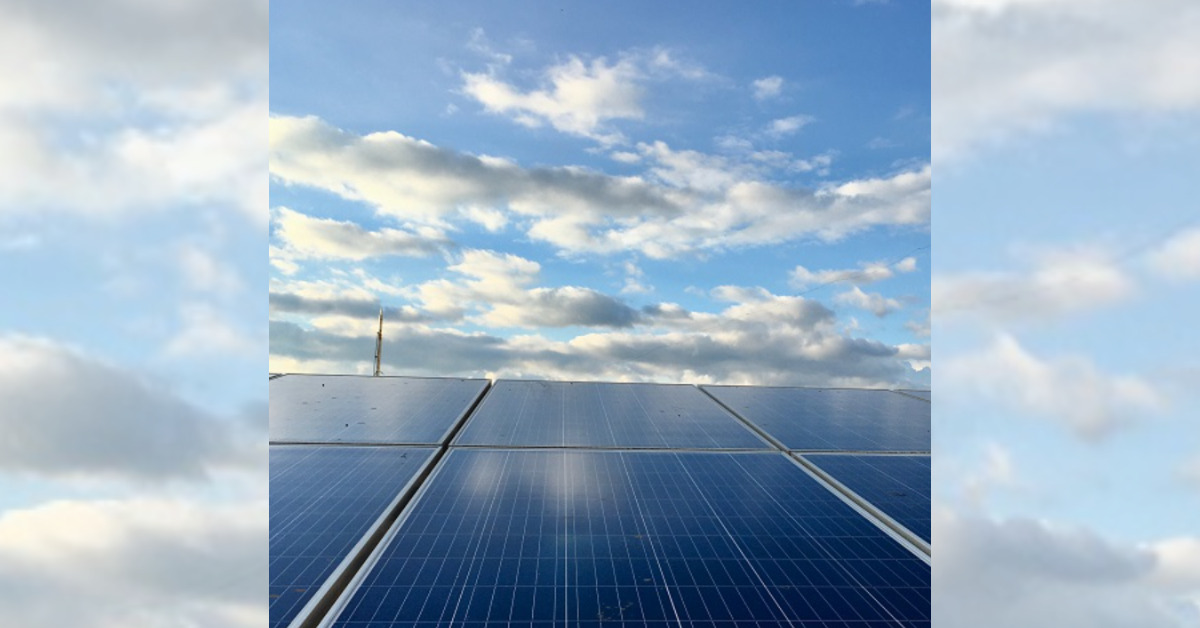
[…] panels don’t generate enough electricity to meet your home’s needs (for example, during cloudy days or at night), the grid-tied inverter seamlessly pulls additional power from the grid to make up for […]